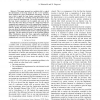Free Online Productivity Tools
i2Speak
i2Symbol
i2OCR
iTex2Img
iWeb2Print
iWeb2Shot
i2Type
iPdf2Split
iPdf2Merge
i2Bopomofo
i2Arabic
i2Style
i2Image
i2PDF
iLatex2Rtf
Sci2ools
ICRA
2007
IEEE
2007
IEEE
Exploiting the Information at the Loop Closure in SLAM
— This paper presents two methods able to exploit the information at the loop closure in the SLAM problem. Both methods have three fundamental advantages. The first one is that to apply the loop closure constraint they do not require to compute any correlation among the features which are not observed simultaneously. The second advantage is that the loop closure constraint can be applied only once at the end (even after more than one loop) in a single step with low computational complexity. Hence, the computational complexity during the robot exploration is independent of the number of features. Finally, the third advantage is that the linearization does not affect the estimation process. This especially holds for the second method, which is based on the Levenberg-Marquardt algorithm. The first method is based on the Extended Kalman Filter. Simulations show that these approaches significantly outperform the conventional EKF based SLAM both in the computational cost and in the map ...
Related Content
| Added | 03 Jun 2010 |
| Updated | 03 Jun 2010 |
| Type | Conference |
| Year | 2007 |
| Where | ICRA |
| Authors | Agostino Martinelli, Roland Siegwart |
Comments (0)

